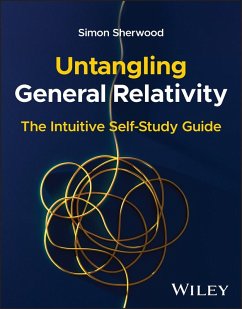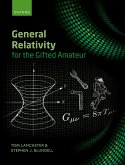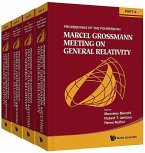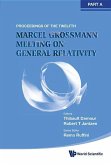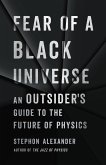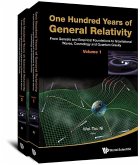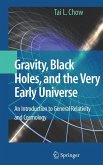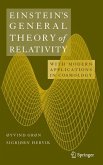- Broschiertes Buch
- Merkliste
- Auf die Merkliste
- Bewerten Bewerten
- Teilen
- Produkt teilen
- Produkterinnerung
- Produkterinnerung
An easy-to-read introduction to Einstein's theory of general relativity In Untangling General Relativity, Simon Sherwood explains the details of general relativity with clarity, enthusiasm, and a sense of fun. Designed to be accessible to non-experts, the book combines intuitive explanations with the essential mathematics needed for a deep understanding of the subject. Sherwood introduces that maths gradually and clearly, in a step-by-step program designed to expand your appreciation and grasp of general relativity. Untangling General Relativity serves as an effective springboard for more…mehr
Andere Kunden interessierten sich auch für
![General Relativity for the Gifted Amateur General Relativity for the Gifted Amateur]() Tom LancasterGeneral Relativity for the Gifted Amateur180,99 €
Tom LancasterGeneral Relativity for the Gifted Amateur180,99 €![Fourteenth Marcel Grossmann Meeting, The: On Recent Developments in Theoretical and Experimental General Relativity, Astrophysics, and Relativistic Field Theories - Proceedings of the Mg14 Meeting on General Relativity (in 4 Parts) Fourteenth Marcel Grossmann Meeting, The: On Recent Developments in Theoretical and Experimental General Relativity, Astrophysics, and Relativistic Field Theories - Proceedings of the Mg14 Meeting on General Relativity (in 4 Parts)]() Fourteenth Marcel Grossmann Meeting, The: On Recent Developments in Theoretical and Experimental General Relativity, Astrophysics, and Relativistic Field Theories - Proceedings of the Mg14 Meeting on General Relativity (in 4 Parts)1.520,99 €
Fourteenth Marcel Grossmann Meeting, The: On Recent Developments in Theoretical and Experimental General Relativity, Astrophysics, and Relativistic Field Theories - Proceedings of the Mg14 Meeting on General Relativity (in 4 Parts)1.520,99 €![Twelfth Marcel Grossmann Meeting, The: On Recent Developments in Theoretical and Experimental General Relativity, Astrophysics and Relativistic Field Theories - Proceedings of the Mg12 Meeting on General Relativity (in 3 Volumes) Twelfth Marcel Grossmann Meeting, The: On Recent Developments in Theoretical and Experimental General Relativity, Astrophysics and Relativistic Field Theories - Proceedings of the Mg12 Meeting on General Relativity (in 3 Volumes)]() Twelfth Marcel Grossmann Meeting, The: On Recent Developments in Theoretical and Experimental General Relativity, Astrophysics and Relativistic Field Theories - Proceedings of the Mg12 Meeting on General Relativity (in 3 Volumes)842,99 €
Twelfth Marcel Grossmann Meeting, The: On Recent Developments in Theoretical and Experimental General Relativity, Astrophysics and Relativistic Field Theories - Proceedings of the Mg12 Meeting on General Relativity (in 3 Volumes)842,99 €![Fear of a Black Universe Fear of a Black Universe]() Stephon AlexanderFear of a Black Universe27,99 €
Stephon AlexanderFear of a Black Universe27,99 €![One Hundred Years of General Relativity: From Genesis and Empirical Foundations to Gravitational Waves, Cosmology and Quantum Gravity (in 2 Volumes) One Hundred Years of General Relativity: From Genesis and Empirical Foundations to Gravitational Waves, Cosmology and Quantum Gravity (in 2 Volumes)]() One Hundred Years of General Relativity: From Genesis and Empirical Foundations to Gravitational Waves, Cosmology and Quantum Gravity (in 2 Volumes)219,99 €
One Hundred Years of General Relativity: From Genesis and Empirical Foundations to Gravitational Waves, Cosmology and Quantum Gravity (in 2 Volumes)219,99 €![Gravity, Black Holes, and the Very Early Universe Gravity, Black Holes, and the Very Early Universe]() Tai L. ChowGravity, Black Holes, and the Very Early Universe46,99 €
Tai L. ChowGravity, Black Holes, and the Very Early Universe46,99 €![Einstein's General Theory of Relativity Einstein's General Theory of Relativity]() Øyvind GrønEinstein's General Theory of Relativity60,99 €
Øyvind GrønEinstein's General Theory of Relativity60,99 €-
-
-
An easy-to-read introduction to Einstein's theory of general relativity In Untangling General Relativity, Simon Sherwood explains the details of general relativity with clarity, enthusiasm, and a sense of fun. Designed to be accessible to non-experts, the book combines intuitive explanations with the essential mathematics needed for a deep understanding of the subject. Sherwood introduces that maths gradually and clearly, in a step-by-step program designed to expand your appreciation and grasp of general relativity. Untangling General Relativity serves as an effective springboard for more in-depth studies. It lays the groundwork for mastering the advanced topics covered in relativity textbooks and university physics courses. Readers will find: * A thorough introduction to general relativity, including the interpretation of gravity as curved spacetime and a full derivation of Einstein's field equations * Comprehensive explanations of the spacetime metric, the equivalence principle, the geodesic equation, and the energy-momentum and curvature tensors * Vacuum curvature: the Schwarzschild and Kerr metrics, black holes, white holes, event horizons, and gravitational waves * Cosmology: the Friedmann equations, dark matter and energy, the Big Bang, inflation and an overview of current efforts to develop a quantum theory of gravity Perfect for undergraduate students preparing to take a university-level physics course dealing with general relativity for the first time, Untangling General Relativity will also benefit students of the natural sciences and instructors and educators with a professional or academic interest in the subject.
Produktdetails
- Produktdetails
- Verlag: Wiley
- Seitenzahl: 336
- Erscheinungstermin: 6. November 2025
- Englisch
- Abmessung: 276mm x 218mm x 25mm
- Gewicht: 930g
- ISBN-13: 9781394355853
- ISBN-10: 1394355858
- Artikelnr.: 74172760
- Herstellerkennzeichnung
- Libri GmbH
- Europaallee 1
- 36244 Bad Hersfeld
- gpsr@libri.de
- Verlag: Wiley
- Seitenzahl: 336
- Erscheinungstermin: 6. November 2025
- Englisch
- Abmessung: 276mm x 218mm x 25mm
- Gewicht: 930g
- ISBN-13: 9781394355853
- ISBN-10: 1394355858
- Artikelnr.: 74172760
- Herstellerkennzeichnung
- Libri GmbH
- Europaallee 1
- 36244 Bad Hersfeld
- gpsr@libri.de
Simon Sherwood is the author of Quantum Untangling (Wiley, 2023). Previously he was Chairman of Elegant Hotels PLC and the CEO of Orient-Express Hotels. He holds an MBA from Harvard Business School and is also a former strategy consultant with the Boston Consulting Group.
Acknowledgements xii
Introduction xiii
Module I The Essentials 1
1 Overview 3
1.1 Einstein Field Equations 3
1.2 Gravity as Curved Spacetime 5
1.3 The Equivalence Principle 6
1.4 Working Out the Details 7
1.5 Gimme, Gimme, Gimme... Some Hard Evidence 7
1.6 The Cosmological Constant 8
1.7 Vacuum Curvature 8
1.8 Cosmology 9
1.9 The Field Equations in Full Form 11
2 Special Relativity 13
2.1 Relativity 13
2.2 The Speed of Light Is Constant: So What? 14
2.3 The Invariant Interval Equation 15
2.4 Time Dilation Quantified 16
2.5 Length Contraction 17
2.6 Leading Clocks Lag 18
2.7 Adding Things Up: An Apparent Paradox 19
2.8 Energy and Momentum 20
2.9 Energy, Momentum, Time and Space 21
2.10 Summary 22
3 The Metric 23
3.1 The Minkowski Metric 23
3.2 Einstein's Tensor and the Metric 25
3.3 Distortion in the Metric 25
3.4 Curvature, Dung Balls and a First Hint of Gravity 28
3.5 A Mathematical Challenge 29
3.6 Upper and Lower Indices 30
3.7 Raising/Lowering Indices with Wonky Metrics (Off-Diagonal Terms) 32
3.8 Summary 34
4 Covariant Derivatives and Christoffel Symbols 37
4.1 Covariant Derivatives 37
4.2 Christoffel Symbols 39
4.3 Summary 43
5 The Geodesic Equation and Gravity 45
5.1 A 2-D Model of Time Dilation and Gravitational Acceleration 45
5.2 The Geodesic Equation 46
5.3 What Happens to the Dung Beetle? 48
5.4 Albert Versus Isaac: Differences Emerge 49
5.5 Albert Versus Isaac: Seeing the Light 51
5.6 A Victory for Einstein 52
5.7 Time Dilation: Hafele-Keating and GPS 53
5.8 Geodesic Summary 54
5.9 Tensors: Why...? What...? How...? 55
5.10 Where's the Fridge? 55
6 The Equivalence Principle and Ricci Tensor 57
6.1 The Equivalence Principle 57
6.2 From Newton's Gravity to Geodesic Separation 60
6.3 The Magnificent Ricci Tensor 62
6.4 An Intuitive Explanation of the Ricci Tensor 62
6.5 Vacuum Curvature: An Apparent Paradox 64
6.6 The Ricci Scalar 65
6.7 Summary 65
7 The Maths of Curvature 67
7.1 Parallel Transport 67
7.2 The Riemann Tensor 68
7.3 Calculating the Ricci Tensor 72
7.4 Calculating the Ricci Scalar 73
7.5 Example Calculations: Aarrgghh! 73
7.6 Hunting for Vacuum Solutions 76
7.7 Summary 77
8 The Energy-Momentum Tensor 79
8.1 Tensor Indices 79
8.2 Introduction to the Energy-Momentum Tensor 80
8.3 Mass Density Flow of Dust 81
8.4 Energy-Momentum Tensor of Dust 83
8.5 Symmetry of the Energy-Momentum Tensor 84
8.6 Covariant Derivative of the Energy-Momentum Tensor 84
8.7 Energy-Momentum Tensor of a Perfect Fluid 85
8.8 Summary 86
9 Deriving the Einstein Field Equations 89
9.1 Why Does Energy-Momentum Curve Spacetime? 89
9.2 Generalising Coordinates 90
9.3 The Ricci Tensor: Why So Complicated? 91
9.4 Deriving the Ricci Relationship 92
9.5 What Does This Tell Us About Spacetime Curvature? 94
9.6 Curvature Footprints 96
9.7 Summary 97
10 Einstein Field Equations: The Full Story 99
10.1 Einstein's Weak Field Metric 99
10.2 Energy-Momentum, Curvature and the Vacuum 103
10.3 Calculating the Value of Einstein's Gravitational Constant 103
10.4 The Poisson Equation (Optional Refresher) 104
10.5 The EFEs in Full Form (Almost!) 106
10.6 The Cosmological Constant 106
10.7 Summary 107
11 Module Summary and Conventions 109
11.1 Module Summary 109
11.2 The Field Equations in Full Form (Finally!) 111
11.3 Why Does Energy-Momentum Distort Spacetime? 112
11.4 Conventions (Optional) 112
11.5 Stationary Action Derivation of the EFEs 114
11.6 Final Thoughts on This Module 115
11.7 Module Memory Jogger 116
Module II Vacuum Curvature 119
12 The Schwarzschild Metric: Derivation 121
12.1 Metric Symmetries: A Diagonal Metric 122
12.2 Ricci and Riemann Symmetries 123
12.3 Simon's Ricci Cheat Sheet 124
12.4 Deriving the Schwarzschild Metric: Relating Time and Space 126
12.5 Birkhoff's Theorem 127
12.6 The Schwarzschild Metric 127
12.7 Summary 128
12.8 Why Do We Care? 129
12.9 Schwarzschild with Cosmological Constant (Optional) 129
13 Schwarzschild and Black Holes 133
13.1 Schwarzschild Revisited 134
13.2 Black Holes: Overview 134
13.3 Minky and Schwart 136
13.4 Proper Acceleration 137
13.5 White Dwarfs and Neutron Stars 138
13.6 Falling into a Black Hole 140
13.7 Time: For Minky the Clock Stops 142
13.8 A Simple Illustrative Model 143
13.9 Space: Schwarzschild Radial Coordinate 145
13.10 Inside the Event Horizon 147
13.11 Summary 148
14 Orbits and Conserved Quantities 151
14.1 Noether, Killing Vectors and Conservation Laws 151
14.2 Conserved Quantities Along Geodesics 153
14.3 Conserved Quantities of the Schwarzschild Metric 154
14.4 Radial Plunge 155
14.5 Angular Momentum and Rotational Energy 157
14.6 A Few Words 158
14.7 Orbits and Trajectories 159
14.8 Quasars 163
14.9 Summary 165
15 Revisiting Einstein's Success (Optional) 167
15.1 The Deflection of Light and Gravitational Lensing 167
15.2 The Precession of Mercury 170
15.3 The Aftermath 174
16 Schwarzschild: Other Coordinates 175
16.1 Introduction for Dummies 175
16.2 Eddington-Finkelstein Coordinates 176
16.3 Intuitive EF 177
16.4 Crossing the Black Hole Event Horizon 179
16.5 White Holes 180
16.6 Kruskal-Szekeres Coordinates 181
16.7 The KS Big Picture Schwarzschild Diagram 183
16.8 Penrose-Carter Diagrams 185
16.9 Schwarzschild Metric: Final Thoughts 186
17 Kerr Metric: An Intuitive Introduction 189
17.1 The Kerr Metric Using BL Coordinates 190
17.2 Why Angular Momentum Matters 191
17.3 An Oblate Spheroid 193
17.4 BL Radial Coordinate Mathematics (Optional) 194
17.5 Minkowski Spacetime Using the BL Radial Coordinate 196
17.6 The Other BL Coordinates 196
17.7 Summary 196
18 Kerr Black Holes 199
18.1 The Outer Event Horizon 199
18.2 The Inner Event Horizon 201
18.3 Underlying Riemann Curvature 201
18.4 The Kerr Singularity (Ringularity) 202
18.5 Frame-Dragging 203
18.6 The Ergosphere 204
18.7 Penrose, Blandford-Znajek and Quasars (Revisited) 205
18.8 Extremal Black Holes and Cosmic Censorship 206
18.9 Conserved Quantities and Contorted Orbits 207
18.10 Maximal Extension of the Kerr Metric 208
18.11 Summary 210
18.12 Cosmic Censorship and the Kerr Metric (Optional) 211
19 Gravitational Waves 215
19.1 Einstein's Flip-Flop 215
19.2 The Maths of GW Radiation 216
19.3 Tell Me More About Gravitational Waves 220
19.4 Chirp GW150914: A Case Study 221
19.5 Chirp GW170817 222
19.6 Pulsar Timing Arrays 223
19.7 A Note on Hawking Radiation 223
19.8 Summary 226
20 Module Summary: Vacuum Curvature 227
20.1 Schwarzschild Metric 227
20.2 Kerr Metric 228
20.3 Gravitational Waves and Hawking Radiation 229
20.4 Module Memory Jogger 230
Module III Cosmology 233
21 The Friedmann-Robertson-Walker Metric 235
21.1 The Cosmological Principle 235
21.2 The Hubble Parameter 236
21.3 The Expanding Universe: A Newtonian View 237
21.4 General Relativity View: A Co-Moving Frame 237
21.5 Introduction to 3-D Spatial Curvature 239
21.6 Spatial Curvature in the FRW Metric (Optional) 240
21.7 The FRW Metric 242
21.8 Ricci Curvature and the Cosmological Principle 242
21.9 Summary 243
22 The Friedmann Equations 245
22.1 FRW Metric: Ricci Calculation 245
22.2 Deriving the Friedmann Equations 247
22.3 The Cosmic Rest Frame 249
22.4 Energy-Density and Expansion 250
22.5 Dominant Relationships 253
22.6 The Accelerating Effect of Vacuum Energy 254
22.7 Critical Energy-Density 254
22.8 Summary 255
23 Welcome to the Dark Side 257
23.1 Spatial Curvature: Feeling Flat 257
23.2 Dark Matter 258
23.3 Modelling the Universe 259
23.4 Radiation's Trivial Contribution 261
23.5 The Cosmic Age Problem: Globular Clusters 261
23.6 The Accelerating Universe 262
23.7 Summary: The Energy Mix of the Universe 265
23.8 What Is Dark (Vacuum) Energy? 266
24 After the Big Bang 269
24.1 Dating the Early Universe 270
24.2 Baryogenesis (Protons and Neutrons Form) 271
24.3 Nuclear Fusion (Light Atomic Nuclei Form) 272
24.4 Cosmic Microwave Background 273
24.5 A Star Is Born 274
24.6 Our Place in the Cosmic Web 275
24.7 Horizons and the Fate of the Universe 277
24.8 Summary 279
25 Inflation 281
25.1 Arguments for Inflation 282
25.2 Introduction to Inflation 285
25.3 The Inflaton Field 286
25.4 How Much Inflation Had to Occur? 287
25.5 The Maths Behind the Inflaton Field (Optional) 289
25.6 Quantum Field Fluctuations 291
25.7 Evidence for Inflation in the CMB 292
25.8 The Inflationary Multiverse 293
25.9 Summary 294
26 Interpreting the CMB (Optional) 295
26.1 Underlying Causes of CMB Temperature Variation 296
26.2 The CMB Power Spectrum 296
26.3 Super-Horizon Anisotropy 298
26.4 Effect of Baryon Acoustic Oscillations 298
26.5 Peak-1 and Measuring Flatness 299
26.6 Comparing Peaks: Another Measure of Baryon Density 299
27 Module Summary: Cosmology 301
27.1 Theory 301
27.2 Observation 302
27.3 From the Big Bang to Today 304
27.4 Some Bits That Might Not Fit 304
27.5 Inflation 305
27.6 Cosmology: Watch the News 306
27.7 Module Memory Jogger 307
28 The Big Challenge 309
28.1 General Relativity Versus Quantum Mechanics 309
28.2 The Challenge 310
28.3 String Theory 310
28.4 Loop Quantum Gravity 312
28.5 Spacetime Is Doomed 314
28.6 Entropic Gravity 315
28.7 Postquantum Gravity 316
28.8 Toodle-Pip! 318
Index 319
Introduction xiii
Module I The Essentials 1
1 Overview 3
1.1 Einstein Field Equations 3
1.2 Gravity as Curved Spacetime 5
1.3 The Equivalence Principle 6
1.4 Working Out the Details 7
1.5 Gimme, Gimme, Gimme... Some Hard Evidence 7
1.6 The Cosmological Constant 8
1.7 Vacuum Curvature 8
1.8 Cosmology 9
1.9 The Field Equations in Full Form 11
2 Special Relativity 13
2.1 Relativity 13
2.2 The Speed of Light Is Constant: So What? 14
2.3 The Invariant Interval Equation 15
2.4 Time Dilation Quantified 16
2.5 Length Contraction 17
2.6 Leading Clocks Lag 18
2.7 Adding Things Up: An Apparent Paradox 19
2.8 Energy and Momentum 20
2.9 Energy, Momentum, Time and Space 21
2.10 Summary 22
3 The Metric 23
3.1 The Minkowski Metric 23
3.2 Einstein's Tensor and the Metric 25
3.3 Distortion in the Metric 25
3.4 Curvature, Dung Balls and a First Hint of Gravity 28
3.5 A Mathematical Challenge 29
3.6 Upper and Lower Indices 30
3.7 Raising/Lowering Indices with Wonky Metrics (Off-Diagonal Terms) 32
3.8 Summary 34
4 Covariant Derivatives and Christoffel Symbols 37
4.1 Covariant Derivatives 37
4.2 Christoffel Symbols 39
4.3 Summary 43
5 The Geodesic Equation and Gravity 45
5.1 A 2-D Model of Time Dilation and Gravitational Acceleration 45
5.2 The Geodesic Equation 46
5.3 What Happens to the Dung Beetle? 48
5.4 Albert Versus Isaac: Differences Emerge 49
5.5 Albert Versus Isaac: Seeing the Light 51
5.6 A Victory for Einstein 52
5.7 Time Dilation: Hafele-Keating and GPS 53
5.8 Geodesic Summary 54
5.9 Tensors: Why...? What...? How...? 55
5.10 Where's the Fridge? 55
6 The Equivalence Principle and Ricci Tensor 57
6.1 The Equivalence Principle 57
6.2 From Newton's Gravity to Geodesic Separation 60
6.3 The Magnificent Ricci Tensor 62
6.4 An Intuitive Explanation of the Ricci Tensor 62
6.5 Vacuum Curvature: An Apparent Paradox 64
6.6 The Ricci Scalar 65
6.7 Summary 65
7 The Maths of Curvature 67
7.1 Parallel Transport 67
7.2 The Riemann Tensor 68
7.3 Calculating the Ricci Tensor 72
7.4 Calculating the Ricci Scalar 73
7.5 Example Calculations: Aarrgghh! 73
7.6 Hunting for Vacuum Solutions 76
7.7 Summary 77
8 The Energy-Momentum Tensor 79
8.1 Tensor Indices 79
8.2 Introduction to the Energy-Momentum Tensor 80
8.3 Mass Density Flow of Dust 81
8.4 Energy-Momentum Tensor of Dust 83
8.5 Symmetry of the Energy-Momentum Tensor 84
8.6 Covariant Derivative of the Energy-Momentum Tensor 84
8.7 Energy-Momentum Tensor of a Perfect Fluid 85
8.8 Summary 86
9 Deriving the Einstein Field Equations 89
9.1 Why Does Energy-Momentum Curve Spacetime? 89
9.2 Generalising Coordinates 90
9.3 The Ricci Tensor: Why So Complicated? 91
9.4 Deriving the Ricci Relationship 92
9.5 What Does This Tell Us About Spacetime Curvature? 94
9.6 Curvature Footprints 96
9.7 Summary 97
10 Einstein Field Equations: The Full Story 99
10.1 Einstein's Weak Field Metric 99
10.2 Energy-Momentum, Curvature and the Vacuum 103
10.3 Calculating the Value of Einstein's Gravitational Constant 103
10.4 The Poisson Equation (Optional Refresher) 104
10.5 The EFEs in Full Form (Almost!) 106
10.6 The Cosmological Constant 106
10.7 Summary 107
11 Module Summary and Conventions 109
11.1 Module Summary 109
11.2 The Field Equations in Full Form (Finally!) 111
11.3 Why Does Energy-Momentum Distort Spacetime? 112
11.4 Conventions (Optional) 112
11.5 Stationary Action Derivation of the EFEs 114
11.6 Final Thoughts on This Module 115
11.7 Module Memory Jogger 116
Module II Vacuum Curvature 119
12 The Schwarzschild Metric: Derivation 121
12.1 Metric Symmetries: A Diagonal Metric 122
12.2 Ricci and Riemann Symmetries 123
12.3 Simon's Ricci Cheat Sheet 124
12.4 Deriving the Schwarzschild Metric: Relating Time and Space 126
12.5 Birkhoff's Theorem 127
12.6 The Schwarzschild Metric 127
12.7 Summary 128
12.8 Why Do We Care? 129
12.9 Schwarzschild with Cosmological Constant (Optional) 129
13 Schwarzschild and Black Holes 133
13.1 Schwarzschild Revisited 134
13.2 Black Holes: Overview 134
13.3 Minky and Schwart 136
13.4 Proper Acceleration 137
13.5 White Dwarfs and Neutron Stars 138
13.6 Falling into a Black Hole 140
13.7 Time: For Minky the Clock Stops 142
13.8 A Simple Illustrative Model 143
13.9 Space: Schwarzschild Radial Coordinate 145
13.10 Inside the Event Horizon 147
13.11 Summary 148
14 Orbits and Conserved Quantities 151
14.1 Noether, Killing Vectors and Conservation Laws 151
14.2 Conserved Quantities Along Geodesics 153
14.3 Conserved Quantities of the Schwarzschild Metric 154
14.4 Radial Plunge 155
14.5 Angular Momentum and Rotational Energy 157
14.6 A Few Words 158
14.7 Orbits and Trajectories 159
14.8 Quasars 163
14.9 Summary 165
15 Revisiting Einstein's Success (Optional) 167
15.1 The Deflection of Light and Gravitational Lensing 167
15.2 The Precession of Mercury 170
15.3 The Aftermath 174
16 Schwarzschild: Other Coordinates 175
16.1 Introduction for Dummies 175
16.2 Eddington-Finkelstein Coordinates 176
16.3 Intuitive EF 177
16.4 Crossing the Black Hole Event Horizon 179
16.5 White Holes 180
16.6 Kruskal-Szekeres Coordinates 181
16.7 The KS Big Picture Schwarzschild Diagram 183
16.8 Penrose-Carter Diagrams 185
16.9 Schwarzschild Metric: Final Thoughts 186
17 Kerr Metric: An Intuitive Introduction 189
17.1 The Kerr Metric Using BL Coordinates 190
17.2 Why Angular Momentum Matters 191
17.3 An Oblate Spheroid 193
17.4 BL Radial Coordinate Mathematics (Optional) 194
17.5 Minkowski Spacetime Using the BL Radial Coordinate 196
17.6 The Other BL Coordinates 196
17.7 Summary 196
18 Kerr Black Holes 199
18.1 The Outer Event Horizon 199
18.2 The Inner Event Horizon 201
18.3 Underlying Riemann Curvature 201
18.4 The Kerr Singularity (Ringularity) 202
18.5 Frame-Dragging 203
18.6 The Ergosphere 204
18.7 Penrose, Blandford-Znajek and Quasars (Revisited) 205
18.8 Extremal Black Holes and Cosmic Censorship 206
18.9 Conserved Quantities and Contorted Orbits 207
18.10 Maximal Extension of the Kerr Metric 208
18.11 Summary 210
18.12 Cosmic Censorship and the Kerr Metric (Optional) 211
19 Gravitational Waves 215
19.1 Einstein's Flip-Flop 215
19.2 The Maths of GW Radiation 216
19.3 Tell Me More About Gravitational Waves 220
19.4 Chirp GW150914: A Case Study 221
19.5 Chirp GW170817 222
19.6 Pulsar Timing Arrays 223
19.7 A Note on Hawking Radiation 223
19.8 Summary 226
20 Module Summary: Vacuum Curvature 227
20.1 Schwarzschild Metric 227
20.2 Kerr Metric 228
20.3 Gravitational Waves and Hawking Radiation 229
20.4 Module Memory Jogger 230
Module III Cosmology 233
21 The Friedmann-Robertson-Walker Metric 235
21.1 The Cosmological Principle 235
21.2 The Hubble Parameter 236
21.3 The Expanding Universe: A Newtonian View 237
21.4 General Relativity View: A Co-Moving Frame 237
21.5 Introduction to 3-D Spatial Curvature 239
21.6 Spatial Curvature in the FRW Metric (Optional) 240
21.7 The FRW Metric 242
21.8 Ricci Curvature and the Cosmological Principle 242
21.9 Summary 243
22 The Friedmann Equations 245
22.1 FRW Metric: Ricci Calculation 245
22.2 Deriving the Friedmann Equations 247
22.3 The Cosmic Rest Frame 249
22.4 Energy-Density and Expansion 250
22.5 Dominant Relationships 253
22.6 The Accelerating Effect of Vacuum Energy 254
22.7 Critical Energy-Density 254
22.8 Summary 255
23 Welcome to the Dark Side 257
23.1 Spatial Curvature: Feeling Flat 257
23.2 Dark Matter 258
23.3 Modelling the Universe 259
23.4 Radiation's Trivial Contribution 261
23.5 The Cosmic Age Problem: Globular Clusters 261
23.6 The Accelerating Universe 262
23.7 Summary: The Energy Mix of the Universe 265
23.8 What Is Dark (Vacuum) Energy? 266
24 After the Big Bang 269
24.1 Dating the Early Universe 270
24.2 Baryogenesis (Protons and Neutrons Form) 271
24.3 Nuclear Fusion (Light Atomic Nuclei Form) 272
24.4 Cosmic Microwave Background 273
24.5 A Star Is Born 274
24.6 Our Place in the Cosmic Web 275
24.7 Horizons and the Fate of the Universe 277
24.8 Summary 279
25 Inflation 281
25.1 Arguments for Inflation 282
25.2 Introduction to Inflation 285
25.3 The Inflaton Field 286
25.4 How Much Inflation Had to Occur? 287
25.5 The Maths Behind the Inflaton Field (Optional) 289
25.6 Quantum Field Fluctuations 291
25.7 Evidence for Inflation in the CMB 292
25.8 The Inflationary Multiverse 293
25.9 Summary 294
26 Interpreting the CMB (Optional) 295
26.1 Underlying Causes of CMB Temperature Variation 296
26.2 The CMB Power Spectrum 296
26.3 Super-Horizon Anisotropy 298
26.4 Effect of Baryon Acoustic Oscillations 298
26.5 Peak-1 and Measuring Flatness 299
26.6 Comparing Peaks: Another Measure of Baryon Density 299
27 Module Summary: Cosmology 301
27.1 Theory 301
27.2 Observation 302
27.3 From the Big Bang to Today 304
27.4 Some Bits That Might Not Fit 304
27.5 Inflation 305
27.6 Cosmology: Watch the News 306
27.7 Module Memory Jogger 307
28 The Big Challenge 309
28.1 General Relativity Versus Quantum Mechanics 309
28.2 The Challenge 310
28.3 String Theory 310
28.4 Loop Quantum Gravity 312
28.5 Spacetime Is Doomed 314
28.6 Entropic Gravity 315
28.7 Postquantum Gravity 316
28.8 Toodle-Pip! 318
Index 319
Acknowledgements xii
Introduction xiii
Module I The Essentials 1
1 Overview 3
1.1 Einstein Field Equations 3
1.2 Gravity as Curved Spacetime 5
1.3 The Equivalence Principle 6
1.4 Working Out the Details 7
1.5 Gimme, Gimme, Gimme... Some Hard Evidence 7
1.6 The Cosmological Constant 8
1.7 Vacuum Curvature 8
1.8 Cosmology 9
1.9 The Field Equations in Full Form 11
2 Special Relativity 13
2.1 Relativity 13
2.2 The Speed of Light Is Constant: So What? 14
2.3 The Invariant Interval Equation 15
2.4 Time Dilation Quantified 16
2.5 Length Contraction 17
2.6 Leading Clocks Lag 18
2.7 Adding Things Up: An Apparent Paradox 19
2.8 Energy and Momentum 20
2.9 Energy, Momentum, Time and Space 21
2.10 Summary 22
3 The Metric 23
3.1 The Minkowski Metric 23
3.2 Einstein's Tensor and the Metric 25
3.3 Distortion in the Metric 25
3.4 Curvature, Dung Balls and a First Hint of Gravity 28
3.5 A Mathematical Challenge 29
3.6 Upper and Lower Indices 30
3.7 Raising/Lowering Indices with Wonky Metrics (Off-Diagonal Terms) 32
3.8 Summary 34
4 Covariant Derivatives and Christoffel Symbols 37
4.1 Covariant Derivatives 37
4.2 Christoffel Symbols 39
4.3 Summary 43
5 The Geodesic Equation and Gravity 45
5.1 A 2-D Model of Time Dilation and Gravitational Acceleration 45
5.2 The Geodesic Equation 46
5.3 What Happens to the Dung Beetle? 48
5.4 Albert Versus Isaac: Differences Emerge 49
5.5 Albert Versus Isaac: Seeing the Light 51
5.6 A Victory for Einstein 52
5.7 Time Dilation: Hafele-Keating and GPS 53
5.8 Geodesic Summary 54
5.9 Tensors: Why...? What...? How...? 55
5.10 Where's the Fridge? 55
6 The Equivalence Principle and Ricci Tensor 57
6.1 The Equivalence Principle 57
6.2 From Newton's Gravity to Geodesic Separation 60
6.3 The Magnificent Ricci Tensor 62
6.4 An Intuitive Explanation of the Ricci Tensor 62
6.5 Vacuum Curvature: An Apparent Paradox 64
6.6 The Ricci Scalar 65
6.7 Summary 65
7 The Maths of Curvature 67
7.1 Parallel Transport 67
7.2 The Riemann Tensor 68
7.3 Calculating the Ricci Tensor 72
7.4 Calculating the Ricci Scalar 73
7.5 Example Calculations: Aarrgghh! 73
7.6 Hunting for Vacuum Solutions 76
7.7 Summary 77
8 The Energy-Momentum Tensor 79
8.1 Tensor Indices 79
8.2 Introduction to the Energy-Momentum Tensor 80
8.3 Mass Density Flow of Dust 81
8.4 Energy-Momentum Tensor of Dust 83
8.5 Symmetry of the Energy-Momentum Tensor 84
8.6 Covariant Derivative of the Energy-Momentum Tensor 84
8.7 Energy-Momentum Tensor of a Perfect Fluid 85
8.8 Summary 86
9 Deriving the Einstein Field Equations 89
9.1 Why Does Energy-Momentum Curve Spacetime? 89
9.2 Generalising Coordinates 90
9.3 The Ricci Tensor: Why So Complicated? 91
9.4 Deriving the Ricci Relationship 92
9.5 What Does This Tell Us About Spacetime Curvature? 94
9.6 Curvature Footprints 96
9.7 Summary 97
10 Einstein Field Equations: The Full Story 99
10.1 Einstein's Weak Field Metric 99
10.2 Energy-Momentum, Curvature and the Vacuum 103
10.3 Calculating the Value of Einstein's Gravitational Constant 103
10.4 The Poisson Equation (Optional Refresher) 104
10.5 The EFEs in Full Form (Almost!) 106
10.6 The Cosmological Constant 106
10.7 Summary 107
11 Module Summary and Conventions 109
11.1 Module Summary 109
11.2 The Field Equations in Full Form (Finally!) 111
11.3 Why Does Energy-Momentum Distort Spacetime? 112
11.4 Conventions (Optional) 112
11.5 Stationary Action Derivation of the EFEs 114
11.6 Final Thoughts on This Module 115
11.7 Module Memory Jogger 116
Module II Vacuum Curvature 119
12 The Schwarzschild Metric: Derivation 121
12.1 Metric Symmetries: A Diagonal Metric 122
12.2 Ricci and Riemann Symmetries 123
12.3 Simon's Ricci Cheat Sheet 124
12.4 Deriving the Schwarzschild Metric: Relating Time and Space 126
12.5 Birkhoff's Theorem 127
12.6 The Schwarzschild Metric 127
12.7 Summary 128
12.8 Why Do We Care? 129
12.9 Schwarzschild with Cosmological Constant (Optional) 129
13 Schwarzschild and Black Holes 133
13.1 Schwarzschild Revisited 134
13.2 Black Holes: Overview 134
13.3 Minky and Schwart 136
13.4 Proper Acceleration 137
13.5 White Dwarfs and Neutron Stars 138
13.6 Falling into a Black Hole 140
13.7 Time: For Minky the Clock Stops 142
13.8 A Simple Illustrative Model 143
13.9 Space: Schwarzschild Radial Coordinate 145
13.10 Inside the Event Horizon 147
13.11 Summary 148
14 Orbits and Conserved Quantities 151
14.1 Noether, Killing Vectors and Conservation Laws 151
14.2 Conserved Quantities Along Geodesics 153
14.3 Conserved Quantities of the Schwarzschild Metric 154
14.4 Radial Plunge 155
14.5 Angular Momentum and Rotational Energy 157
14.6 A Few Words 158
14.7 Orbits and Trajectories 159
14.8 Quasars 163
14.9 Summary 165
15 Revisiting Einstein's Success (Optional) 167
15.1 The Deflection of Light and Gravitational Lensing 167
15.2 The Precession of Mercury 170
15.3 The Aftermath 174
16 Schwarzschild: Other Coordinates 175
16.1 Introduction for Dummies 175
16.2 Eddington-Finkelstein Coordinates 176
16.3 Intuitive EF 177
16.4 Crossing the Black Hole Event Horizon 179
16.5 White Holes 180
16.6 Kruskal-Szekeres Coordinates 181
16.7 The KS Big Picture Schwarzschild Diagram 183
16.8 Penrose-Carter Diagrams 185
16.9 Schwarzschild Metric: Final Thoughts 186
17 Kerr Metric: An Intuitive Introduction 189
17.1 The Kerr Metric Using BL Coordinates 190
17.2 Why Angular Momentum Matters 191
17.3 An Oblate Spheroid 193
17.4 BL Radial Coordinate Mathematics (Optional) 194
17.5 Minkowski Spacetime Using the BL Radial Coordinate 196
17.6 The Other BL Coordinates 196
17.7 Summary 196
18 Kerr Black Holes 199
18.1 The Outer Event Horizon 199
18.2 The Inner Event Horizon 201
18.3 Underlying Riemann Curvature 201
18.4 The Kerr Singularity (Ringularity) 202
18.5 Frame-Dragging 203
18.6 The Ergosphere 204
18.7 Penrose, Blandford-Znajek and Quasars (Revisited) 205
18.8 Extremal Black Holes and Cosmic Censorship 206
18.9 Conserved Quantities and Contorted Orbits 207
18.10 Maximal Extension of the Kerr Metric 208
18.11 Summary 210
18.12 Cosmic Censorship and the Kerr Metric (Optional) 211
19 Gravitational Waves 215
19.1 Einstein's Flip-Flop 215
19.2 The Maths of GW Radiation 216
19.3 Tell Me More About Gravitational Waves 220
19.4 Chirp GW150914: A Case Study 221
19.5 Chirp GW170817 222
19.6 Pulsar Timing Arrays 223
19.7 A Note on Hawking Radiation 223
19.8 Summary 226
20 Module Summary: Vacuum Curvature 227
20.1 Schwarzschild Metric 227
20.2 Kerr Metric 228
20.3 Gravitational Waves and Hawking Radiation 229
20.4 Module Memory Jogger 230
Module III Cosmology 233
21 The Friedmann-Robertson-Walker Metric 235
21.1 The Cosmological Principle 235
21.2 The Hubble Parameter 236
21.3 The Expanding Universe: A Newtonian View 237
21.4 General Relativity View: A Co-Moving Frame 237
21.5 Introduction to 3-D Spatial Curvature 239
21.6 Spatial Curvature in the FRW Metric (Optional) 240
21.7 The FRW Metric 242
21.8 Ricci Curvature and the Cosmological Principle 242
21.9 Summary 243
22 The Friedmann Equations 245
22.1 FRW Metric: Ricci Calculation 245
22.2 Deriving the Friedmann Equations 247
22.3 The Cosmic Rest Frame 249
22.4 Energy-Density and Expansion 250
22.5 Dominant Relationships 253
22.6 The Accelerating Effect of Vacuum Energy 254
22.7 Critical Energy-Density 254
22.8 Summary 255
23 Welcome to the Dark Side 257
23.1 Spatial Curvature: Feeling Flat 257
23.2 Dark Matter 258
23.3 Modelling the Universe 259
23.4 Radiation's Trivial Contribution 261
23.5 The Cosmic Age Problem: Globular Clusters 261
23.6 The Accelerating Universe 262
23.7 Summary: The Energy Mix of the Universe 265
23.8 What Is Dark (Vacuum) Energy? 266
24 After the Big Bang 269
24.1 Dating the Early Universe 270
24.2 Baryogenesis (Protons and Neutrons Form) 271
24.3 Nuclear Fusion (Light Atomic Nuclei Form) 272
24.4 Cosmic Microwave Background 273
24.5 A Star Is Born 274
24.6 Our Place in the Cosmic Web 275
24.7 Horizons and the Fate of the Universe 277
24.8 Summary 279
25 Inflation 281
25.1 Arguments for Inflation 282
25.2 Introduction to Inflation 285
25.3 The Inflaton Field 286
25.4 How Much Inflation Had to Occur? 287
25.5 The Maths Behind the Inflaton Field (Optional) 289
25.6 Quantum Field Fluctuations 291
25.7 Evidence for Inflation in the CMB 292
25.8 The Inflationary Multiverse 293
25.9 Summary 294
26 Interpreting the CMB (Optional) 295
26.1 Underlying Causes of CMB Temperature Variation 296
26.2 The CMB Power Spectrum 296
26.3 Super-Horizon Anisotropy 298
26.4 Effect of Baryon Acoustic Oscillations 298
26.5 Peak-1 and Measuring Flatness 299
26.6 Comparing Peaks: Another Measure of Baryon Density 299
27 Module Summary: Cosmology 301
27.1 Theory 301
27.2 Observation 302
27.3 From the Big Bang to Today 304
27.4 Some Bits That Might Not Fit 304
27.5 Inflation 305
27.6 Cosmology: Watch the News 306
27.7 Module Memory Jogger 307
28 The Big Challenge 309
28.1 General Relativity Versus Quantum Mechanics 309
28.2 The Challenge 310
28.3 String Theory 310
28.4 Loop Quantum Gravity 312
28.5 Spacetime Is Doomed 314
28.6 Entropic Gravity 315
28.7 Postquantum Gravity 316
28.8 Toodle-Pip! 318
Index 319
Introduction xiii
Module I The Essentials 1
1 Overview 3
1.1 Einstein Field Equations 3
1.2 Gravity as Curved Spacetime 5
1.3 The Equivalence Principle 6
1.4 Working Out the Details 7
1.5 Gimme, Gimme, Gimme... Some Hard Evidence 7
1.6 The Cosmological Constant 8
1.7 Vacuum Curvature 8
1.8 Cosmology 9
1.9 The Field Equations in Full Form 11
2 Special Relativity 13
2.1 Relativity 13
2.2 The Speed of Light Is Constant: So What? 14
2.3 The Invariant Interval Equation 15
2.4 Time Dilation Quantified 16
2.5 Length Contraction 17
2.6 Leading Clocks Lag 18
2.7 Adding Things Up: An Apparent Paradox 19
2.8 Energy and Momentum 20
2.9 Energy, Momentum, Time and Space 21
2.10 Summary 22
3 The Metric 23
3.1 The Minkowski Metric 23
3.2 Einstein's Tensor and the Metric 25
3.3 Distortion in the Metric 25
3.4 Curvature, Dung Balls and a First Hint of Gravity 28
3.5 A Mathematical Challenge 29
3.6 Upper and Lower Indices 30
3.7 Raising/Lowering Indices with Wonky Metrics (Off-Diagonal Terms) 32
3.8 Summary 34
4 Covariant Derivatives and Christoffel Symbols 37
4.1 Covariant Derivatives 37
4.2 Christoffel Symbols 39
4.3 Summary 43
5 The Geodesic Equation and Gravity 45
5.1 A 2-D Model of Time Dilation and Gravitational Acceleration 45
5.2 The Geodesic Equation 46
5.3 What Happens to the Dung Beetle? 48
5.4 Albert Versus Isaac: Differences Emerge 49
5.5 Albert Versus Isaac: Seeing the Light 51
5.6 A Victory for Einstein 52
5.7 Time Dilation: Hafele-Keating and GPS 53
5.8 Geodesic Summary 54
5.9 Tensors: Why...? What...? How...? 55
5.10 Where's the Fridge? 55
6 The Equivalence Principle and Ricci Tensor 57
6.1 The Equivalence Principle 57
6.2 From Newton's Gravity to Geodesic Separation 60
6.3 The Magnificent Ricci Tensor 62
6.4 An Intuitive Explanation of the Ricci Tensor 62
6.5 Vacuum Curvature: An Apparent Paradox 64
6.6 The Ricci Scalar 65
6.7 Summary 65
7 The Maths of Curvature 67
7.1 Parallel Transport 67
7.2 The Riemann Tensor 68
7.3 Calculating the Ricci Tensor 72
7.4 Calculating the Ricci Scalar 73
7.5 Example Calculations: Aarrgghh! 73
7.6 Hunting for Vacuum Solutions 76
7.7 Summary 77
8 The Energy-Momentum Tensor 79
8.1 Tensor Indices 79
8.2 Introduction to the Energy-Momentum Tensor 80
8.3 Mass Density Flow of Dust 81
8.4 Energy-Momentum Tensor of Dust 83
8.5 Symmetry of the Energy-Momentum Tensor 84
8.6 Covariant Derivative of the Energy-Momentum Tensor 84
8.7 Energy-Momentum Tensor of a Perfect Fluid 85
8.8 Summary 86
9 Deriving the Einstein Field Equations 89
9.1 Why Does Energy-Momentum Curve Spacetime? 89
9.2 Generalising Coordinates 90
9.3 The Ricci Tensor: Why So Complicated? 91
9.4 Deriving the Ricci Relationship 92
9.5 What Does This Tell Us About Spacetime Curvature? 94
9.6 Curvature Footprints 96
9.7 Summary 97
10 Einstein Field Equations: The Full Story 99
10.1 Einstein's Weak Field Metric 99
10.2 Energy-Momentum, Curvature and the Vacuum 103
10.3 Calculating the Value of Einstein's Gravitational Constant 103
10.4 The Poisson Equation (Optional Refresher) 104
10.5 The EFEs in Full Form (Almost!) 106
10.6 The Cosmological Constant 106
10.7 Summary 107
11 Module Summary and Conventions 109
11.1 Module Summary 109
11.2 The Field Equations in Full Form (Finally!) 111
11.3 Why Does Energy-Momentum Distort Spacetime? 112
11.4 Conventions (Optional) 112
11.5 Stationary Action Derivation of the EFEs 114
11.6 Final Thoughts on This Module 115
11.7 Module Memory Jogger 116
Module II Vacuum Curvature 119
12 The Schwarzschild Metric: Derivation 121
12.1 Metric Symmetries: A Diagonal Metric 122
12.2 Ricci and Riemann Symmetries 123
12.3 Simon's Ricci Cheat Sheet 124
12.4 Deriving the Schwarzschild Metric: Relating Time and Space 126
12.5 Birkhoff's Theorem 127
12.6 The Schwarzschild Metric 127
12.7 Summary 128
12.8 Why Do We Care? 129
12.9 Schwarzschild with Cosmological Constant (Optional) 129
13 Schwarzschild and Black Holes 133
13.1 Schwarzschild Revisited 134
13.2 Black Holes: Overview 134
13.3 Minky and Schwart 136
13.4 Proper Acceleration 137
13.5 White Dwarfs and Neutron Stars 138
13.6 Falling into a Black Hole 140
13.7 Time: For Minky the Clock Stops 142
13.8 A Simple Illustrative Model 143
13.9 Space: Schwarzschild Radial Coordinate 145
13.10 Inside the Event Horizon 147
13.11 Summary 148
14 Orbits and Conserved Quantities 151
14.1 Noether, Killing Vectors and Conservation Laws 151
14.2 Conserved Quantities Along Geodesics 153
14.3 Conserved Quantities of the Schwarzschild Metric 154
14.4 Radial Plunge 155
14.5 Angular Momentum and Rotational Energy 157
14.6 A Few Words 158
14.7 Orbits and Trajectories 159
14.8 Quasars 163
14.9 Summary 165
15 Revisiting Einstein's Success (Optional) 167
15.1 The Deflection of Light and Gravitational Lensing 167
15.2 The Precession of Mercury 170
15.3 The Aftermath 174
16 Schwarzschild: Other Coordinates 175
16.1 Introduction for Dummies 175
16.2 Eddington-Finkelstein Coordinates 176
16.3 Intuitive EF 177
16.4 Crossing the Black Hole Event Horizon 179
16.5 White Holes 180
16.6 Kruskal-Szekeres Coordinates 181
16.7 The KS Big Picture Schwarzschild Diagram 183
16.8 Penrose-Carter Diagrams 185
16.9 Schwarzschild Metric: Final Thoughts 186
17 Kerr Metric: An Intuitive Introduction 189
17.1 The Kerr Metric Using BL Coordinates 190
17.2 Why Angular Momentum Matters 191
17.3 An Oblate Spheroid 193
17.4 BL Radial Coordinate Mathematics (Optional) 194
17.5 Minkowski Spacetime Using the BL Radial Coordinate 196
17.6 The Other BL Coordinates 196
17.7 Summary 196
18 Kerr Black Holes 199
18.1 The Outer Event Horizon 199
18.2 The Inner Event Horizon 201
18.3 Underlying Riemann Curvature 201
18.4 The Kerr Singularity (Ringularity) 202
18.5 Frame-Dragging 203
18.6 The Ergosphere 204
18.7 Penrose, Blandford-Znajek and Quasars (Revisited) 205
18.8 Extremal Black Holes and Cosmic Censorship 206
18.9 Conserved Quantities and Contorted Orbits 207
18.10 Maximal Extension of the Kerr Metric 208
18.11 Summary 210
18.12 Cosmic Censorship and the Kerr Metric (Optional) 211
19 Gravitational Waves 215
19.1 Einstein's Flip-Flop 215
19.2 The Maths of GW Radiation 216
19.3 Tell Me More About Gravitational Waves 220
19.4 Chirp GW150914: A Case Study 221
19.5 Chirp GW170817 222
19.6 Pulsar Timing Arrays 223
19.7 A Note on Hawking Radiation 223
19.8 Summary 226
20 Module Summary: Vacuum Curvature 227
20.1 Schwarzschild Metric 227
20.2 Kerr Metric 228
20.3 Gravitational Waves and Hawking Radiation 229
20.4 Module Memory Jogger 230
Module III Cosmology 233
21 The Friedmann-Robertson-Walker Metric 235
21.1 The Cosmological Principle 235
21.2 The Hubble Parameter 236
21.3 The Expanding Universe: A Newtonian View 237
21.4 General Relativity View: A Co-Moving Frame 237
21.5 Introduction to 3-D Spatial Curvature 239
21.6 Spatial Curvature in the FRW Metric (Optional) 240
21.7 The FRW Metric 242
21.8 Ricci Curvature and the Cosmological Principle 242
21.9 Summary 243
22 The Friedmann Equations 245
22.1 FRW Metric: Ricci Calculation 245
22.2 Deriving the Friedmann Equations 247
22.3 The Cosmic Rest Frame 249
22.4 Energy-Density and Expansion 250
22.5 Dominant Relationships 253
22.6 The Accelerating Effect of Vacuum Energy 254
22.7 Critical Energy-Density 254
22.8 Summary 255
23 Welcome to the Dark Side 257
23.1 Spatial Curvature: Feeling Flat 257
23.2 Dark Matter 258
23.3 Modelling the Universe 259
23.4 Radiation's Trivial Contribution 261
23.5 The Cosmic Age Problem: Globular Clusters 261
23.6 The Accelerating Universe 262
23.7 Summary: The Energy Mix of the Universe 265
23.8 What Is Dark (Vacuum) Energy? 266
24 After the Big Bang 269
24.1 Dating the Early Universe 270
24.2 Baryogenesis (Protons and Neutrons Form) 271
24.3 Nuclear Fusion (Light Atomic Nuclei Form) 272
24.4 Cosmic Microwave Background 273
24.5 A Star Is Born 274
24.6 Our Place in the Cosmic Web 275
24.7 Horizons and the Fate of the Universe 277
24.8 Summary 279
25 Inflation 281
25.1 Arguments for Inflation 282
25.2 Introduction to Inflation 285
25.3 The Inflaton Field 286
25.4 How Much Inflation Had to Occur? 287
25.5 The Maths Behind the Inflaton Field (Optional) 289
25.6 Quantum Field Fluctuations 291
25.7 Evidence for Inflation in the CMB 292
25.8 The Inflationary Multiverse 293
25.9 Summary 294
26 Interpreting the CMB (Optional) 295
26.1 Underlying Causes of CMB Temperature Variation 296
26.2 The CMB Power Spectrum 296
26.3 Super-Horizon Anisotropy 298
26.4 Effect of Baryon Acoustic Oscillations 298
26.5 Peak-1 and Measuring Flatness 299
26.6 Comparing Peaks: Another Measure of Baryon Density 299
27 Module Summary: Cosmology 301
27.1 Theory 301
27.2 Observation 302
27.3 From the Big Bang to Today 304
27.4 Some Bits That Might Not Fit 304
27.5 Inflation 305
27.6 Cosmology: Watch the News 306
27.7 Module Memory Jogger 307
28 The Big Challenge 309
28.1 General Relativity Versus Quantum Mechanics 309
28.2 The Challenge 310
28.3 String Theory 310
28.4 Loop Quantum Gravity 312
28.5 Spacetime Is Doomed 314
28.6 Entropic Gravity 315
28.7 Postquantum Gravity 316
28.8 Toodle-Pip! 318
Index 319

